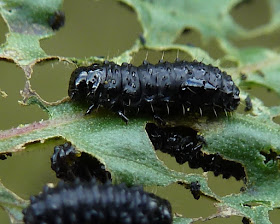However, there is another way in which the story continues. These and almost any other guides you can find cover adults - eggs, larvae and pupae are rarely mentioned. Of course, it is adults that are usually found and which form the core of any biological collection. However, it does mean much of the group's life history is neglected. There are good reasons for this - juvenile stages tend to be small, hidden away (not always the case for larvae though - see below) and tricky to identify, the latter because in many cases they've never knowingly been found. A quick skim through 'the Atlas' shows just how often the words 'Larva - undescribed' are used plus of course larvae come in various stages/instars and these may vary considerably within a single species. A difficulty for sure, but also an opportunity for research and publication, and one that I'm becoming increasingly tempted to work on. To do so will not be easy and those gaps in research may mean a truly comprehensive guide is not yet possible, but I think that there is enough knowledge out there - as specimens, existing publications and the contents of entomologists' brains - to produce something genuinely interesting and useful (e.g. for conservation purposes). First job - collect existing literature, then work through the better known species and lastly fill in as many of the trickier gaps as I can. So, you read it here first - a guide to the juvenile forms of leaf beetles, but don't hold your breath! And to show that not everything is hidden away and hard to find, I'll leave you with a cluster of larvae of the common dock beetle Gastrophysa viridula doing what it does best - eating dock leaves!
 |
| Larvae of Gastrophysa viridula on a dock (Rumex) leaf |
References
Cox, M.L. (2007). Atlas of the Seed and Leaf Beetles of Britain and Ireland. Pisces, Newbury.
Hubble, D. (2012). Keys to the Adults of Seed and Leaf Beetles of Britain and Ireland. FSC, Telford.
No comments:
Post a Comment